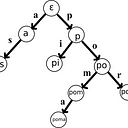Depth First Search Fast AF
Depth First Search (DFS) is a common algorithm used to traverse and search through graphs or tree structures. It involves starting at a root node and exploring as far as possible down each branch before backtracking and exploring the next branch.
In this tutorial, we will implement DFS in Swift and walk through the steps of how it works.
First, let’s create a simple graph structure to use for our example. We will use an adjacency list representation, which is a common way to represent graphs in code. An adjacency list is simply a list of all the nodes in the graph, and each node has a list of its neighboring nodes.
struct Node {
let value: String
var neighbors: [Node]
}
let a = Node(value: "A", neighbors: [])
let b = Node(value: "B", neighbors: [])
let c = Node(value: "C", neighbors: [])
let d = Node(value: "D", neighbors: [])
let e = Node(value: "E", neighbors: [])
a.neighbors = [b, c]
b.neighbors = [a, d, e]
c.neighbors = [a, e]
d.neighbors = [b]
e.neighbors = [b, c]Now that we have our graph set up, let’s define a function to perform the DFS. We will pass in the root node and a target value we are searching for.
func depthFirstSearch(root: Node, target: String) -> Bool {
// Create a set to keep track of visited nodes
var visited = Set<Node>()
// Create a stack to store nodes that need to be explored
var stack = [Node]()
// Add the root node to the stack
stack.append(root)
// While there are still nodes in the stack
while !stack.isEmpty {
// Pop the top node off the stack
let current = stack.popLast()!
// If the current node is the target, return true
if current.value == target {
return true
}
// Mark the current node as visited
visited.insert(current)
// Loop through all the neighbors of the current node
for neighbor in current.neighbors {
// If the neighbor has not been visited, add it to the stack
if !visited.contains(neighbor) {
stack.append(neighbor)
}
}
}
// If the target was not found, return false
return false
}Let’s walk through how this code works. We start by creating a set to keep track of the nodes we have visited and a stack to store the nodes we need to explore. We add the root node to the stack and enter a while loop.
Inside the loop, we pop the top node off the stack and check if it is the target. If it is, we return true. If not, we mark the node as visited and loop through all of its neighbors. If a neighbor has not been visited, we add it to the stack.
If the loop ends and the target was not found, we return false.
Now let’s test our DFS function.
let result = depthFirstSearch(root: a, target: "E")
print(result) // Output: trueIn this example, we start at the root node “A” and explore all its neighbors before moving on to the next branch. We eventually find the target node “E” and return true.
It’s important to note that DFS is not always the most efficient way to search through a graph or tree. It can take a long time to explore deep branches before backtracking and exploring other branches. In cases where the target is more likely to be found closer to the root, a Breadth First Search (BFS) may be a better choice.
For more information on DFS and other graph traversal algorithms, check out the following resources:
I hope this tutorial has helped you understand how to implement depth first search in Swift and how it works. Happy coding!
